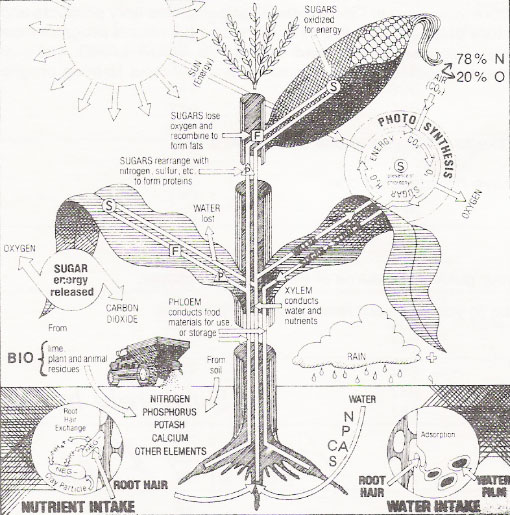How Plants Obtain Nutrients
How Plants Obtain Nutrients
Plants Can Obtain Nutrients In Three Ways
Farmers, who are top yield crop producers certainly don’t take fertility for granted. But have you ever wondered how a corn or soybean plant gets its nutrients?
You can broadcast fertilizer, plow down fertilizer, or foliar spray but nutrients won’t help the crop until they are absorbed by the roots and move into the plant, or move directly into the plant thru the leaves. Up to 100% efficiency can be obtained thru foliar feeding.
There are 3 ways plants can obtain nutrients thru the roots: 1. by contact. 2. mass-flow. 3. diffusion.
Many miles of roots lie under an acre of corn. But since the roots occupy less than 1 % of the total soil volume, a very small amount of plant food is intercepted by them as they grow thru the soil. In an acre of corn only 6 lb. of N, 2 lb. of P, and 6 lb. of K are removed by contact with the roots, in normal broadcast application of traditional dry fertilizers (Univ. of Purdue study). But with use of select plant food solution, proper energy release material (corn syrup) and select biologicals, the exchangeability of N-P-K can be over tripled with direct seed application. Also, timing and placement of N is very important for top efficiency.
Most nutrients must move to the roots. One way they move is by mass-flow. Plants take up water from the soil. And water that flows thru the soil to the roots contains some nutrients. Mass-flow supplies much of the nitrate N, calcium, sulfate, and magnesium. However, smaller amounts of P & K goes to the roots by mass-flow. Nitrate N, or calcium, for example that move by mass-flow need only be in moist soil that has actively absorbing roots available. It makes little difference how N gets into moist soil. Side-band placement moved N to the roots by mass-flow just as much as plowdown placement. However, in dry conditions, or in soil types low in humus or N03 (nitrate nitrogen), N needs to be banded (3-5″) from the crop at the proper time for optimum use by a good root system.
Most P and K reach the roots by diffusion. Only P and K that is within one-fourth inch of the roots will diffuse toward the root for uptake. This is why a direct seed starter, or row pop up is so important to a young plant. Proper balance of nutrients is vital for healthy and vigorous plants (twice P as K). P and K need a high root density in most soils to get greater utilization of added fertilizer. Nearly all N can be used by the growing crop thru mass-flow. On the other hand, not all applied P and K is removed because a high percent is too far away from the roots for uptake. Or is the type of nutrient that plants don’t like!
Plants don’t like acid unnatural materials, contaminated mixes with chlorine and other heavy metals. SAVE YOUR MONEY ON heavy NPK applications of commercial fertilizers, and build a healthy soil life.
Roots can also change the pH and salt content of the soil. This in turn will change the availability of nutrients. The form of N used will affect the pH change that occurs. Plants that fed only on ammonium N will make the soil near the root more acid. The best N solution contains both ammonium N (23 %) and urea (52 %) and N03 (25 %).



